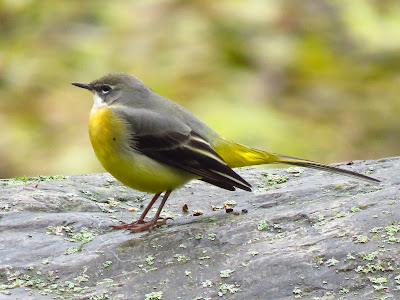An unexpected encounter with a Grey Wagtail this morning at Pearson Park reminded me to finish this blog post, which I started a couple of weeks ago. Grey Wagtails are small energetic birds almost always found near water. Their traditional breeding habitat are fast flowing upland rivers and streams, while during winter they are much more widespread, including towns and cities, where they can be found in parks and even by garden ponds, sometimes away from water. Despite their name, the general impression is of a very yellow bird. They have yellow underparts, with the brightest colour under their tail. The mantle and head are grey, with a pale throat and superciliary arches. The male develops a black throat in the breeding season. They continuously wag their tail as they forage for small invertebrates on the water's edge. Despite this and their bright colours then can be surprisingly hard to spot.
Breeding urban Grey Wagtails
Until 2019, Grey Wagtails were wintering birds in Hull, with most sightings between October and December, with favoured locations at the parks. However, in 2019, I started to come across Grey Wagtails regularly in the breeding season around a few places around town: by the River Hull by Croda, and by Scale Lane bridge, at East Park and in town near Princes Quay. In 2019 I found a recently fledged young at East Park, and in 2020 an adult carrying food and a fledgling. Richard Broughton had noted the presence of an adult female and an immature at Bransholme Sewage Works in June 2001. All this suggests that several pairs breed in the city. Nesting in suburban habitats in the UK, particularly around sewage farms, was noted as early as the 70s. Grey Wagtails place their nest in cavities in walls, banks and under bridges, sometimes using other birds nests, so it is unlikely that they have a limit in nesting sites.
Conservation









4 comments:
Thanks Africa. So beautiful to see a bit of pure nature in the city.
Thank you Johnty, I'm glad you enjoyed the post!
I usually fingvgrey wagtails adjacent to spring head pumping station in the little stream that goes past the Asda on spring field way
Post a Comment